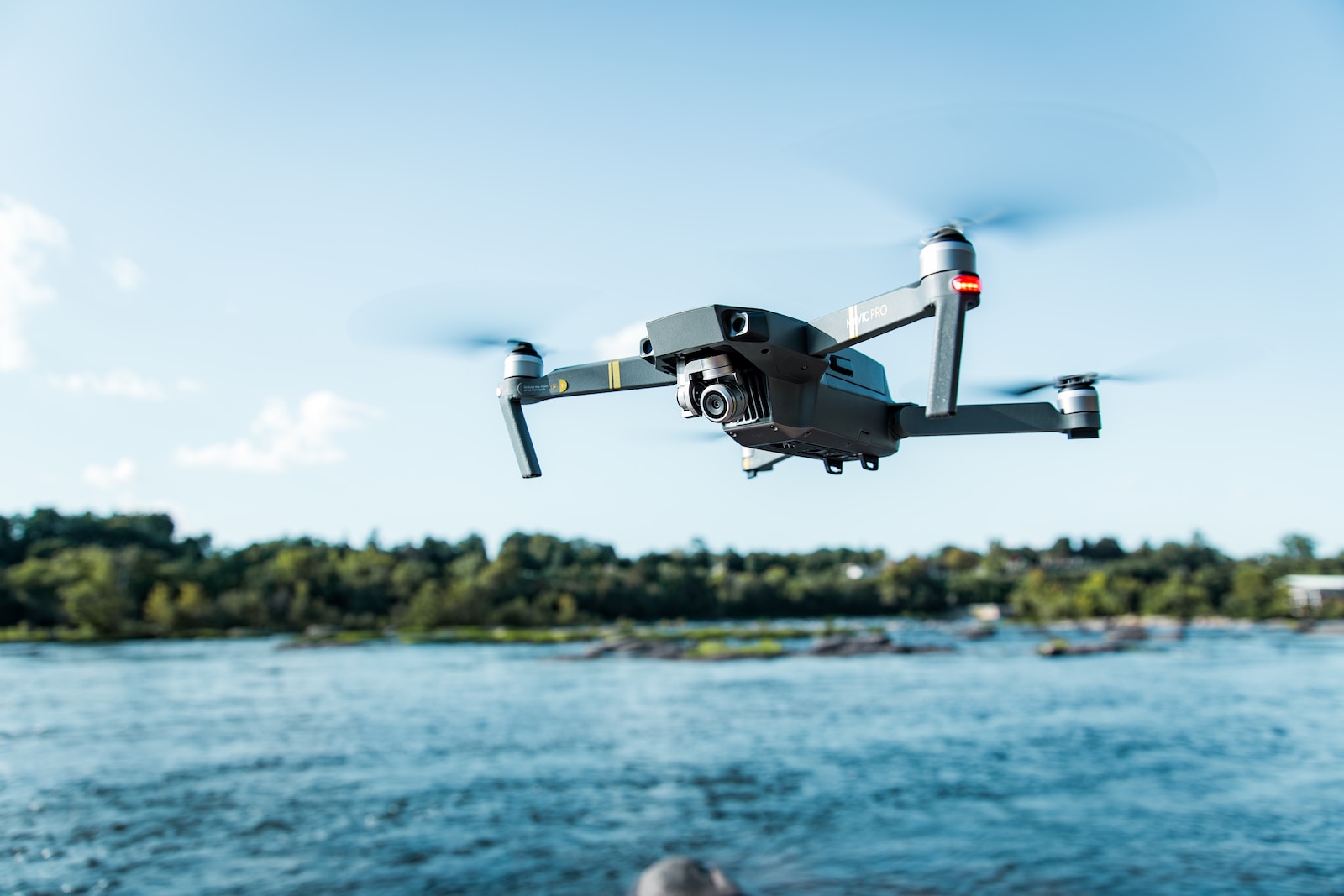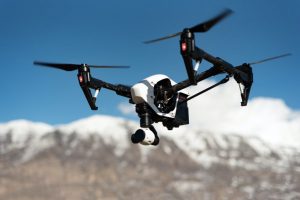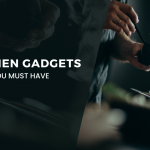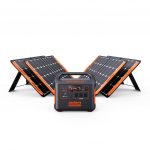Agricultural drones, also known as unmanned aerial vehicles (UAVs), are increasingly used for crop monitoring and analysis in agriculture. These drones are equipped with various sensors and cameras to collect and analyze crop health data, growth patterns, and yields.
The importance of crop monitoring and analysis in agriculture cannot be overstated. It helps farmers make informed decisions about crop management practices, such as irrigation, fertilization, and pest control; this, in turn, can lead to improved crop yields, reduced costs, and better resource management.
Table of Contents
Drone security
Drone security refers to the measures taken to protect unmanned aerial vehicles (UAVs) from unauthorized access, control, interference, and other security threats. With the increasing use of drones in various industries, including military, commercial, recreational, and agricultural drones the need for drone security has become more critical than ever before.
One of the primary risks to drone security is unauthorized access and control; This occurs when an individual or entity gains access to the drone’s control system and takes over its operation; this can lead to serious consequences, such as the drone being used for malicious purposes or causing accidents and injuries.
Another significant risk to drone security is interference and jamming; this can occur when a third party disrupts the drone’s communication and navigation systems, causing it to lose control or crash. Cybersecurity threats like hacking and data breaches are becoming more common as drones become more connected and integrated with other technologies.
Best practices
Various technologies and best practices are being implemented to mitigate these risks and ensure drone security. Authentication and authorization technologies, such as password protection and biometric authentication, ensure that only authorized individuals can access and control the drone. Encryption and data protection technologies secure data transmitted between the drone and its control system.
Anti-jamming and anti-spoofing technologies are also employed to prevent signal interference and manipulation. Counter-drone technologies, such as jamming devices and net guns, are used to disable rogue drones that threaten public safety.
In addition to these technological measures, a legal and regulatory framework has been established to ensure drone security. National and international regulations govern the use of drones and address issues such as privacy and data protection. Liability and insurance requirements are also established to ensure that drone operators are held accountable for any damages or injuries caused by their drones.
Benefits of drone technology
Drone technology has revolutionized various industries, providing various benefits previously impossible or too costly to achieve. Here are some of the key benefits of drone technology:
Improved Efficiency: Drones can perform tasks more efficiently and quickly than humans, saving time and money. For example, in agriculture, drones can survey crops, monitor irrigation systems, and detect pests and diseases much faster and more accurately than manual inspections; this leads to improved crop yields, reduced costs, and better resource management.
Enhanced Safety: Drones can perform dangerous tasks that may threaten human safety, such as inspecting pipelines, power lines, and buildings. Companies can minimize the risk of accidents and injuries by using drones instead of human workers.
Increased Accessibility: Drones can reach remote and inaccessible areas that are difficult or impossible for humans to access; this is particularly useful in disaster response, where drones can search for survivors in unsafe or difficult to access.
Cost Savings: Drones can significantly reduce the cost of operations in various industries. For example, in the construction industry, drones can perform surveying and mapping tasks more quickly and at a lower cost than traditional methods.
Improved Data Collection and Analysis: Drones can collect large amounts of data quickly and accurately, allowing for more informed decision-making. In mining and oil and gas industries, drones can survey and map sites, providing detailed data on terrain, structures, and resources.
Environmental Benefits: Drones can be used to monitor and protect the environment, such as detecting illegal fishing, monitoring wildlife populations, and mapping deforestation.
Drone future use
The future of drone technology is filled with potential applications across various industries. Here are some of the ways that drones are expected to be used in the future:
Delivery Services: One of the most anticipated uses of drone technology is delivering goods and packages. Companies like Amazon and UPS have already begun testing drone delivery services, and drones for deliveries are expected to become more widespread in the coming years.
Infrastructure Inspection: Drones can inspect infrastructure such as bridges, buildings, and pipelines more efficiently and safely than traditional methods. As such, they are expected to be increasingly used for these purposes.
Surveillance and Security: Drones can be used for surveillance and security purposes in various settings, from public safety and law enforcement to border control and military operations. As drone technology improves, their use for these purposes is expected to become more widespread.
Agriculture: Drones are already used for crop monitoring and analysis. They are expected to be used more extensively for precision agriculture, such as the targeted application of fertilizers and pesticides.
Environmental Monitoring: Drones can be used to monitor the environment, such as tracking wildlife populations, detecting pollution, and mapping deforestation. As environmental concerns continue to grow, drones for these purposes are expected to become more common.
Entertainment: Drones are used for entertainment, such as in light shows and aerial photography. As drone technology improves, its use for entertainment is expected to become more widespread and innovative.
Mineral Exploration:
Drones can be used in mineral exploration to provide high-resolution images and data on the terrain and geology of a mining site; this allows for more accurate and efficient mineral exploration, which can help identify potential deposits and improve resource management.
Site Surveying:
Drones equipped with cameras and sensors can map and survey mining sites. This information can help mining companies better understand the layout and topography of a site, allowing for more efficient planning and resource allocation.
Monitoring of Mining Operations:
Drones can monitor mining operations in real-time, providing data on the progress of activities such as the extraction of minerals and transportation of materials. This information can help mining companies make better decisions and improve resource management, increasing productivity and cost savings.
Safety Monitoring:
Drones can be used to monitor the safety of mining operations by detecting potential hazards and monitoring workers’ use of safety equipment; This can help reduce the risk of accidents and injuries and improve the overall safety of mining operations.
Drone limitations
Drones have become increasingly popular and are being used in a variety of applications, but they do have some limitations that need to be considered. Here are some of the key limitations of drones:
Battery Life:
One of the main limitations of drones is their battery life. Most drones can only fly for 20-30 minutes on a single charge, which limits their range and capabilities; this means that drones must be used strategically to ensure they can complete their tasks within their battery life.
Weather Conditions:
Drones are susceptible to weather conditions such as high winds, rain, and snow. These conditions can affect the stability and maneuverability of the drone, which can impact their ability to complete their tasks safely and effectively.
Regulatory Restrictions:
Strict regulations surrounding the use of drones in many areas, including airspace restrictions, flight height limitations, and certification requirements. These regulations can limit the range and applications of drones and may require special permits and training.
Limited Payload Capacity:
Most drones have a limited payload capacity, limiting their ability to carry equipment or sensors needed for certain tasks; this can also limit their ability to complete tasks in remote or difficult-to-access areas.
Vulnerability to Hacking:
Drones rely on wireless communication and navigation systems, making them vulnerable to hacking or interference; this can lead to loss of control of the drone or the theft of sensitive data.
Despite these limitations, drone technology is advancing rapidly. These challenges are addressed by developing new materials, improved battery technology, and enhanced navigation and communication systems. As these technologies continue to improve, the potential applications of drones are likely to expand.
Drone best buy
DJI Mavic 2 Pro drone
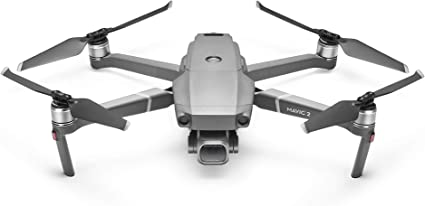
The DJI Mavic 2 Pro’s camera is the standout feature of the drone. Hasselblad, a well-known and respected camera manufacturer, designs it. The camera features a 1-inch CMOS sensor and an adjustable aperture, allowing greater control over field depth and exposure. The camera can shoot 4K video at up to 60 frames per second and 20-megapixel photos. The 3-axis gimbal ensures the footage is stable and vibration-free, even in windy conditions.
Battery Life:
The DJI Mavic 2 Pro boasts a battery life of up to 31 minutes, which is longer than many other drones on the market. This extended flight time allows for more footage to be captured and more creative shots to be taken. The drone’s battery is also easy to replace and can be charged quickly with a dedicated charging hub.
Obstacle Avoidance:
The DJI Mavic 2 Pro has obstacle avoidance sensors on all sides of the drone, which help to prevent collisions during flight. The sensors can detect obstacles up to 20 meters away, and the drone can automatically navigate around them. This feature is particularly useful for novice pilots who may be less familiar with flying drones.
Active Tracking:
The drone’s active tracking mode allows it to follow a subject automatically without manual control. This feature is useful for capturing dynamic footage of moving subjects, such as athletes or animals. The drone can track subjects in front, behind, or to the side and adjust its speed and altitude to keep the subject in the frame.
Intelligent Flight Modes:
The DJI Mavic 2 Pro has a range of intelligent flight modes, which make it easy to capture creative shots without requiring advanced piloting skills. The drone can fly along a pre-determined path using waypoints, capture a 360-degree panoramic shot, or create a hyper-lapse video. These features allow for unique and visually stunning footage.
Foldable Design:
The DJI Mavic 2 Pro’s foldable design makes it easy to transport and store. The drone can be folded to a compact size, easily fitting into a backpack or carrying case. This feature is particularly useful for traveling photographers and videographers.
Features:
- High-quality Hasselblad camera with a 1-inch CMOS sensor and adjustable aperture
- 4K video at up to 60 frames per second and 20-megapixel photos
- 3-axis gimbal for stable footage
- Up to 31 minutes of flight time
- Obstacle avoidance sensors on all sides of the drone
- Active tracking and follow-me mode
- Intelligent flight modes, including waypoints and panoramas
- DJI GO 4 app for easy control and editing of photos and videos
- Foldable design for easy transport
Pros:
- High-quality camera for stunning video and photos
- Long battery life for extended flight time
- Obstacle avoidance sensors for improved safety during flight
- Active tracking and follow-me mode for capturing dynamic shots
- Intelligent flight modes for easy operation and creative shots
- Easy-to-use DJI GO 4 app for control and editing of footage
- Foldable design for easy transport
Cons:
- Expensive price point
- Limited range of up to 8 kilometers
- It can be not easy to fly in high winds
- Heavyweight compared to other drones
DJI Phantom 4 Pro V2.0 drone
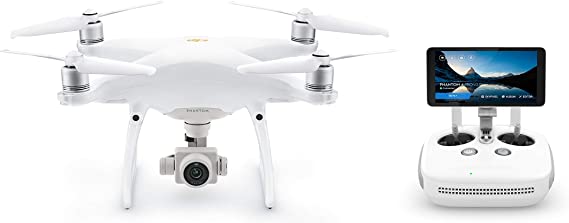
The DJI Phantom 4 Pro V2.0 features a 20-megapixel camera with a 1-inch CMOS sensor, capable of shooting 4K video at up to 60 frames per second. The camera also features a mechanical shutter and adjustable aperture, allowing for greater control over exposure and depth of field. The 3-axis gimbal ensures smooth, stable footage even in windy conditions.
Battery Life:
The DJI Phantom 4 Pro V2.0 has a maximum flight time of up to 28 minutes, which is impressive for a drone of its size and capabilities. The battery is also easily replaced and quickly charged with the included charging hub.
Obstacle Avoidance:
The drone features obstacle avoidance sensors on all sides, which help prevent collisions during flight. The sensors can detect obstacles up to 30 meters away, and the drone can automatically navigate around them. This feature is particularly useful for novice pilots or those flying in unfamiliar areas.
Remote Controller:
The DJI Phantom 4 Pro V2.0 has a remote controller with a built-in screen with a 1080p resolution; this eliminates the need for a smartphone or tablet to view the drone’s footage and control the camera. The remote controller also has a range of up to 7 km, allowing for greater flexibility in flying distance.
Intelligent Flight Modes:
The DJI Phantom 4 Pro V2.0 has a range of intelligent flight modes, including ActiveTrack, which allows the drone to follow a subject automatically, and TapFly, which allows the user to tap on a location on the screen and have the drone fly to that location. The drone also features Draw, which allows the user to draw a path on the screen for the drone to follow. These features make it easier for pilots to capture dynamic footage without requiring advanced piloting skills.
Flight Performance:
The DJI Phantom 4 Pro V2.0 features a top speed of 72 km/h, making it one of the fastest drones on the market. The drone can also reach a maximum altitude of 6 km, higher than many other drones. The drone’s stability and maneuverability make it ideal for capturing footage in challenging conditions.
Remote Monitoring:
The DJI Phantom 4 Pro V2.0 features a remote monitoring system that allows the user to view the drone’s flight status and telemetry data in real-time. This feature can be especially useful for monitoring flight conditions and ensuring the drone’s safety during flight.
Features:
- 20-megapixel camera with a 1-inch CMOS sensor
- Capable of shooting 4K video at up to 60 frames per second
- 3-axis gimbal for smooth, stable footage
- Obstacle avoidance sensors on all sides
- Remote controller with a built-in screen and range of up to 7 km
- Intelligent flight modes, including ActiveTrack, TapFly, and Draw
- Top speed of 72 km/h and a maximum altitude of 6 km
- Remote monitoring system for real-time flight status and telemetry data
Pros:
- High-quality camera and advanced features for professional photographers and videographers
- Long battery life of up to 28 minutes
- Obstacle avoidance sensors for added safety
- Intelligent flight modes make it easier to capture dynamic footage
- Fast speed and high altitude for challenging conditions
- The built-in screen on the remote controller eliminates the need for a smartphone or tablet
Cons:
- Expensive compared to other drones on the market
- Large size and weight can make it more difficult to transport
- It may require some level of piloting skill to utilize its features fully
- Some users have reported occasional glitches with the obstacle avoidance system
PowerVision PowerEgg
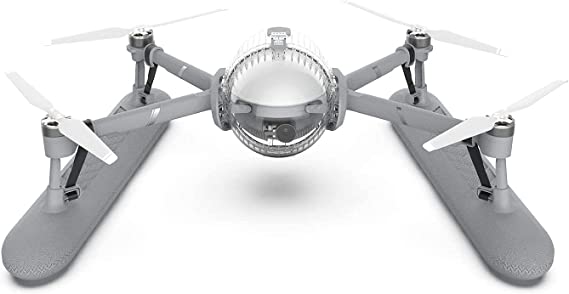
The PowerVision PowerEgg is a relatively large and sturdy drone with a folding design that makes it more compact and easier to transport. It features four powerful motors and a lightweight but durable carbon fiber body. The drone measures 513 x 513 x 310 mm (unfolded) and weighs 3.9 kg, making it slightly heavier than other drones.
Camera System:
One of the standout features of the PowerVision PowerEye is its dual camera system, which includes a 4K camera for capturing traditional footage and a thermal camera for thermal imaging. The cameras can be swapped out easily, allowing users to switch between the two depending on their needs. The drone also features a 3-axis gimbal for smooth, stable footage.
Flight Performance:
The PowerVision PowerEye is designed for professional users and features various advanced flight features. It has a top speed of 65 km/h and a maximum altitude of 5 km, making it suitable for various applications, including surveying, mapping, and search and rescue. The drone features obstacle avoidance sensors on the front and bottom, which help prevent collisions and improve flight safety. It also has a dual battery system that provides a longer flight time of up to 29 minutes.
Additional Features:
The PowerVision PowerEye comes with a range of intelligent flight modes that make it easier to capture dynamic footage. These include Point of Interest, Waypoint, and Follow Me modes. The drone also features a remote controller with a built-in screen and a range of up to 5 km, eliminating the need for a smartphone or tablet. The controller also features a variety of customizable buttons and a built-in HDMI output for live video streaming. The PowerVision PowerEye also has several optional accessories available, including additional batteries and chargers and a waterproof hard case for transport and storage.
Features:
- Dual camera system with a 4K camera and a thermal camera for thermal imaging
- Swappable cameras allow for greater flexibility in capturing different types of footage
- 3-axis gimbal for smooth, stable footage
- Intelligent flight modes, including Point of Interest, Waypoint, and Follow Me
- Obstacle avoidance sensors on the front and bottom of the drone
- Dual battery system for a longer flight time of up to 29 minutes
- Remote controller with a built-in screen and range of up to 5 km
- Folding design for easier transportation
Pros:
- The dual camera system allows for both traditional and thermal imaging
- Obstacle avoidance sensors provide added safety during flights
- Intelligent flight modes make it easier to capture dynamic footage
- Long battery life and dual battery system for extended flight time
- Folding design makes it more portable than some other drones
- The built-in screen on the remote controller eliminates the need for a smartphone or tablet
- Optional accessories and replacement parts are available
Cons:
- Pricey compared to some other drones in its class
- Limited range compared to some other drones on the market
- Some users have reported issues with the obstacle avoidance sensors not detecting certain obstacles
- It may require some level of piloting skill to utilize its features fully
Autel Robotics EVO II (buy on Amazon)
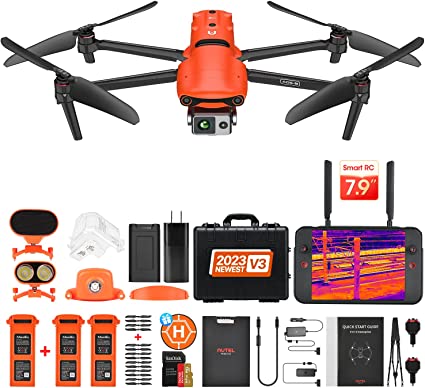
The Autel Robotics EVO II is a professional-grade drone designed for serious photographers and videographers. Its many features make it an excellent choice for capturing stunning aerial footage, including a powerful camera, long battery life, and a stable flight experience.
Design and Build Quality:
The EVO II has a sleek and modern design, with a foldable body that makes it easy to transport and store. The drone is built with high-quality materials, including a durable aluminum frame and carbon fiber arms, ensuring it can withstand daily use rigors.
Camera:
One of the standout features of the EVO II is its camera. The drone comes equipped with a 48-megapixel camera capable of capturing 8K video at 25fps, 6K video at 30fps, 4K video at 60fps, and 1080p video at up to 120fps. The camera is mounted on a 3-axis gimbal that ensures stable footage, even in windy conditions. Additionally, the camera supports various shooting modes, such as HDR, burst, and time-lapse, providing a range of creative options for capturing stunning aerial footage.
Flight Performance:
The EVO II has a maximum flight time of up to 40 minutes, thanks to its 7100mAh battery. This long battery life makes it an excellent choice for professional photographers and videographers who must capture extended footage. The drone also features obstacle avoidance sensors on all sides, which helps to ensure a safe flight experience. Additionally, the EVO II has a range of up to 9km, one of the longest ranges available in a consumer drone.
Pros:
- High-quality camera capable of capturing 8K video
- Long battery life of up to 40 minutes
- Obstacle avoidance sensors on all sides for a safe flight experience
- Range of up to 9km
- Foldable design for easy transport and storage
Cons:
- It can be challenging to set up and operate for beginners
- No obstacle avoidance when flying backward
- Relatively expensive compared to other consumer drones on the market
Holy Stone HS100D (buy on Amazon)
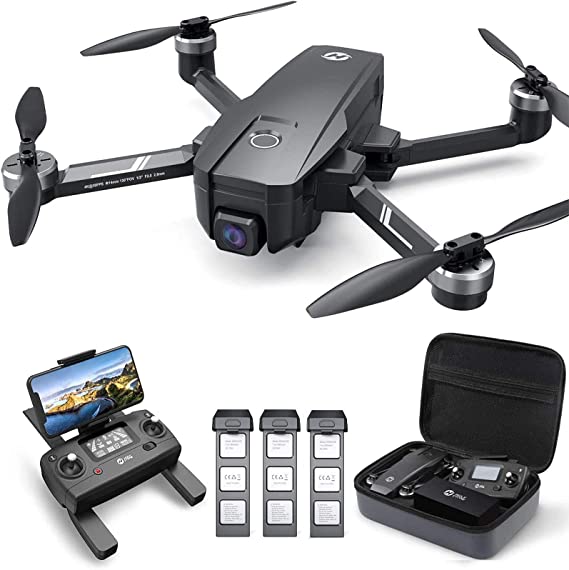
The Holy Stone HS100D has a sleek and modern design with a black and red color scheme. The drone features a foldable design that makes it easy to transport and store. The propeller arms can be easily folded inwards, reducing the overall size of the drone for easy carrying. The drone is made of high-quality materials that make it durable and resistant to crashes.
Camera:
The drone has a 1080P HD camera that can capture stunning photos and videos from the sky. The camera has a wide-angle lens that can capture a broader view and improve the overall image quality. Users can also adjust the camera angle remotely using the remote controller.
Flight Performance:
The Holy Stone HS100D is equipped with a GPS that enables it to fly steadily and follow a pre-set route. The drone also features altitude hold and one-key takeoff and landing functions that make it easy to operate for beginners. It has a maximum flight time of 15 minutes and a maximum control distance of 500 meters. The drone can fly at three different speed levels, allowing users to choose the best speed for their needs.
Remote Controller:
The drone’s remote controller is ergonomic and easy to use, with a built-in LCD screen that displays real-time flight data, such as altitude, distance, and battery life. The controller has two joysticks for controlling the drone’s movement and a range of buttons for controlling the camera and accessing various functions.
Pros:
- Foldable design for easy storage and transport
- 1080P HD camera with a wide-angle lens for stunning aerial photos and videos
- GPS system for stable flight and pre-set routes
- Altitude hold and one-key takeoff and landing functions for easy operation
- Three different speed levels for various flight needs
- Remote controller with an LCD screen for real-time flight data display
Cons:
- Short flight time of 15 minutes
- Limited control distance of 500 meters
- No obstacle avoidance feature
Future of drone security
As drone technology continues to advance, the future of drone security looks bright. With emerging technologies and trends, the drone industry is taking proactive steps to address the challenges of drone security. We’ll explore key emerging technologies, challenges, and opportunities in drone security and the importance of collaboration and partnerships.
Emerging Technologies and Trends
Counter–Drone Technology: Counter-drone technology is a rapidly growing field that aims to prevent unauthorized drones from flying in restricted airspace. This technology uses various methods, such as radar, radio frequency (RF), and acoustic sensors, to detect and intercept rogue drones.
Artificial Intelligence (AI): AI-powered drones have the potential to revolutionize the way we use drones for security purposes. AI algorithms can be trained to identify threats and suspicious behavior, allowing drones to perform autonomous security tasks more efficiently and accurately.
Blockchain Technology: Blockchain technology offers a secure and decentralized way to store and manage drone data, including flight paths, sensor readings, and other important information. This technology could be used to enhance the security and privacy of drone operations and improve transparency and accountability.
Challenges and Opportunities
Privacy Concerns: As drones become more advanced, there are increasing concerns about their impact on privacy. Drones equipped with cameras and sensors can collect sensitive information about individuals and organizations, raising questions about data protection and privacy rights.
Cybersecurity Risks: Drones are vulnerable to cyber attacks, including hacking, malware, and phishing. As drones become more interconnected with other devices and networks, the risk of cyber attacks will likely increase, creating new challenges for drone security.
Regulatory Framework: The lack of a clear regulatory framework for drone security poses a significant challenge for the industry. As the use of drones becomes more widespread, regulators need to establish clear guidelines and standards for drone security to ensure that drones are used safely and responsibly.
Collaboration and Partnerships
Public–Private Partnerships: Collaboration between government agencies, private companies, and other stakeholders is essential to addressing the challenges of drone security. Public-private partnerships can help improve coordination and information-sharing and foster innovation in drone security technology.
Industry Standards and Best Practices: Developing industry standards and best practices can help promote consistency and quality in drone security. These standards and best practices can also enhance transparency and accountability in the drone industry.
Education and Awareness: Raising awareness about the importance of drone security is essential to promoting responsible drone use. Education and training programs can ensure that drone operators know the risks and challenges associated with drone security and are equipped with the knowledge and skills to address these challenges effectively.
Conclusion
In conclusion, drones are becoming an increasingly important tool for various applications, including security. As drone usage continues to expand, it is crucial to ensure that drone security measures are in place to prevent misuse and potential threats.
Drone security is essential for ensuring drones’ safe and secure operation in various applications. Measures such as encryption, remote identification, geofencing, and anti-jamming technologies can help enhance drone security. Establishing collaborations and partnerships between industry, government, and academia to enhance drone security is also important.

